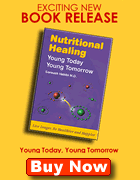|
|
|
||||||||||||
|
|
||||||||||||
|
|
Vitamin Supplements |
||||
What you need to build a healthy and strong body Vitamins are essential for our daily cellular function. Indeed they are absolutely vital for optimal function of the cells. There are well-known diseases, which result from vitamin deficiencies. For example, vitamin B1 deficiency can be associated with Beri-Beri, anxiety, fatigue, mental confusion, etc. Vitamin B2 deficiency could be associated with cracked lips or cracked mouth corners, glossitis (red and painful tongue), geographic tongue, etc. Zinc deficiency may lead to hair loss, white spots on the nails, infertility, low sperm count, slow growth, dermatitis, etc. The problem is that our clever and fascinating body cannot make them. Therefore, we need to get them via our food or supplementation. Many factors can influence our receiving the right amount of vitamins on a daily basis. These include:
So, what do we do? The answer is supplementation. Donít get me wrong. I encourage you to have a healthy diet, a balanced diet, taking 5-7 servings of properly grown fruits and vegetables. In addition I would strongly encourage you to take supplements for the reasons given earlier. RDA (Recommended Dietary Allowances) versus Antioxidant effectAre RDA levels sufficient for prevention of degenerative diseases such as heart disease, cancer, diabetes and so on? The answer is NO. RDA was initially developed as a base line vitamin recommendation to prevent acute diseases like scurvy, rickets, pellagra and so on. However, these diseases are very uncommon nowadays in particular in countries like Australia, USA, most European countries, Canada, Japan and the like. One must ask if RDA levels were sufficient for the prevention of degenerative diseases such as cancer, CHD and so on; why the incidence of degenerative diseases are on the rise.
As discussed in the previous chapters, today we are more exposed to free radicals than ever before. In the old days, when we were not exposed to free radical damage as much the Recommended Daily Allowances (RDA) levels may have been sufficient in the prevention of disease. Today, RDA levels are insufficient for the prevention of degenerative diseases. In order to have antioxidant effect, much higher doses are required. For example, to prevent scurvy one needs to take 30 mg of vitamin C every day. In order to have an antioxidant effect the dose could be between 1 to 30 grams per day. Dr. Linus Pauling used to take up to 18 grams of vitamin C a day. In my practice I use between 15 Ė 30 grams of vitamin C intravenously (IV) in cancer patients. RDA level for vitamin E is 10-15 IU per day. There is no health benefit until we reach 100IU a day. In fact medical research indicates that we need 400-450 IU of vitamin E per day to prevent coronary heart disease (CHD).5 To get 450 IU of vitamin E from our diet one needs to take 80 avocados or 80 mangos or 15 kg of spinach. This is almost impossible. |
Is it safe to take above RDA levels? Yes. Not only is it safe but it is necessary to combat oxidative stress and degenerative diseases. In fact, to see an antioxidant effect much higher doses are required. This will be discussed with specific vitamins. In some countries the RDA for some vitamins have increased. This indicates that government authorities are becoming more aware of the benefits, and also the amount of research available at present. EDR: It is Effective Daily Requirement or therapeutic doses of a vitamin recommended above RDA levels to combat oxidative stress and have therapeutic effects. It has a wide dosage range depending on age, weight, disease and whether the patient is taking any other medication. SafetyHow safe are vitamins? The simple answer is that they are very safe. In fact compared to prescription drugs they are extremely safe. Drug (prescribed medicine) overdose is the fourth common cause of death in USA. FDA (Food & Drug Administration) in USA reported 900,000 deaths from prescription drugs between 1985-1990. During the same period only one person died from niacin overdose. In the same period aspirin killed 640 people.6 It is highly unlikely for a person to take vitamins to commit suicide. They usually take sedatives and strong pain-killers. How long should I take the vitamins for?Basically for life; it is like taking your fruit salad every day. It has been shown that to achieve best results with vitamin therapy, they should be taken long term. The longer they are taken the better the result. There are many reasons for that such as neutralising free radicals, repairing cells, facilitating biochemical reactions, enhancing the immune system to name but a few. How many groups of vitamins are there?There are two groups. Water-soluble such as vitamin C and the B group. They are absorbed rapidly and reach their peak within one hour and leave the body quickly. The half-life is usually four hours and it is best they be taken 3-4 times a day. Fat-soluble vitamins like vitamin A, D, E and K. As vitamin A, D and E are extracted from natural sources such as fish, and their potency from different extracts varies, it was decided to develop an IU (International Unit) in order to standardise their potency. For more information about specific vitamins, please select them in the learn more about box on the left. For more detailed information and specific recommendations, please [click here] to become a member of DrHabibi.com |
|||
|
|
|
||||||||||||
|
|




